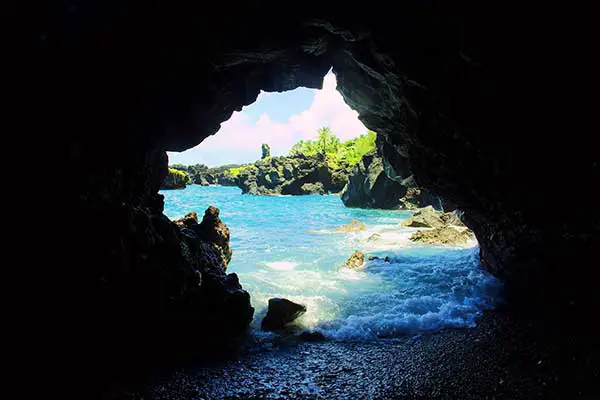If you’re looking for a break from sunny beaches and jungle sights try exploring Maui’s caves. Why are there caves in paradise? Eruptions in the past have hollowed out tunnels under the volcanic soil throughout the island.
While there are more caves located on the Big Island of Hawaii, because of its more recent formation, several caves are still accessible to the public on Maui, from traditional caves, to lava tube caves, and even sea caves.

Traditional caves of Maui
Table of Contents
Waihou Spring Trail
Waihou Spring Trail is an easy to moderate 1.8 mile trail located in Olinda forest, a 15 minute drive up from Makawao.
The well-maintained trail is an easy 0.6 mile loop around the pine forest, with a more challenging side trail down the ridge to Waihou (“new water”) Spring, where you’ll find the caves. The trail is popular, especially among locals, because it’s a serene and enjoyable hike.
The Hike
The trail starts off of Olinda road. After leading you past the State Forest Reserve tree plantation, turns into a loop around the forest. If you’re looking for more than a leisure walk, about half way down the loop you’ll find a side trail that goes down to the caves.
This is where the hike gets a bit more difficult, with semi steep and narrow switchbacks. The walk down is not too bad but the leaf-covered trail can get a bit slippery and muddy, especially if it has been raining.
But the scenery at the bottom of the trail is definitely worth it. Once you get to the bottom, take some time to admire the stunning area. Listen to the sound of the wind blowing the trees around (which strangely enough is reminiscent of the sound of waves crashing) and take a peep inside the tubes before walking back up. That’s the part that will get your heartbeat going. “Are we there yet? One more switchback, I think…”
Don’t expect an impressive waterfall once you get down to the caves. The “spring” is more like a trinkle down the cliff, which is quite mesmerizing and calming and allows you to take a closer look at the intriguing tunnels.
The Myth
The site is nicknamed the “Menehune caves,” after the mythical little people of Hawaii roaming the islands in the pre-settling days. Menehunes lived deep in forests, away from humans, and were believed to be great builders, so its nickname suggests that they had something to do with the caves at Olinda.
At two feet tall, these “dwarves” could easily walk through the small tubes, whereas any adult nowadays would have to crawl through the moist tunnels.
When to go
The trail is open year round and the best time to go is on a dry day, at any time during the day. The hike takes approximately an hour. Explore the forest after a stroll through Makawao town, or after experiencing sunrise at the top of Haleakala.
Upcountry is usually much cooler than the coastal areas so wear closed-toe shoes (that you don’t mind getting dirty) and bring a light sweater or rain jacket, just in case the weather turns.
How to get there:
From Makawao town, drive carefully up Olinda road. If you smell eucalyptus trees, you’re on the right path. A few miles up the road you’ll pass the Maui Bird Conservation Center on the left. After which a dirt lot will appear on the right.
Even on a busy day, there is always room to park. Carefully pull up (some areas have significant holes) and walk up to the gate.
Other things to know:
There are no amenities on the trail or on the road leading up to it. Bring a change of shoes.
Lava Tube Caves
Hana Lava Tube
The Ka’eleku cavern (meaning basaltic rock in hawaiian), most commonly referred to as the Hana Lava Tube, is a self-guided attraction located in Hana, on the east side of Maui.
Formed approximately 1,000 years ago, the Hana Lava Tube is the largest cave accessible to the public on Maui. It is a good stop on your Road to Hana drive, or if you’re spending the day exploring the area, especially with kids.
What’s a lava tube?
Lava tubes are underground passageways created by lava flows beneath the surface of the earth, known in hawaiian as pahoehoe lava (smooth lava). When the flow stops at the end of an eruption it leaves behind an empty cave.
What you’ll see
- Lava, lava, lava! In every shape and form.
- Stalagmites: a rare site on Maui.
- Stalactites referred to as the “Chocolate corridor” because of its resemblance to Hershey’s kisses.
- Other geological wonders described on various signs around the cave.
Tour info and tips
- The showcave is open year round, 7 days a week from 10:30am to 4pm.
- The entrance fee is $15 per person (kids under 5 are admitted for free) and includes the use of a flashlight and a hard hat if you so desire. Bring cash with you, as many places are cash only in Hana.
- The accessible cave is about ⅓ mile long. The tour takes approximately 40 minutes and is good for all skill levels, but wear shoes with a decent grip as it can get slippery.
- Access to the red Ti botanical garden maze as a bonus.
- Amenities: Porta potty, picnic table.
Directions to the Hana Lava Tube cave
On Hana Highway coming from Paia, turn left onto Ulaino road (around mile marker 31). Drive down about half a mile and you’ll see the entrance on your left, where you’ll find a large parking lot.
Bonus cave: Lava tube on the Road to Hana
Right around mile marker 23 on Hana Highway, you’ll find a short lava tube.
A lesser known attraction on the road to Hana, this cave makes for a nice pit stop. But pay close attention or you’ll miss it.
Directions:
Right before the road turns, you’ll see a parking area to the left. Carefully walk across the street and enter through the small hole. Follow the tube to the end and you’ll find a forest and a waterfall.

Sea Caves
Princess Caves at Wai’anapanapa State Park
Over the years, there are many sites and attractions on Maui that are no longer accessible to the public.
Sadly, the Princess caves have been permanently closed for years for safety reasons. There are gates in place and a sign that says the legend of Princess Popoalaea is no longer there. Do not trespass!
Kanaio Coast
The Kanaio coast is the desolate stretch of coast southeast of Maui, known as the backside of Hana.
Several centuries ago, when Haleakala erupted on its south slope, massive amounts of molten lava rushed down to the sea, creating new land, including the enchanting sea caves.
If you’ve done the drive from Hana to Kula, you probably noticed the arches from the road. But if you’re hoping for a closer look at the hidden sea caves, you’ll have to get there by boat.
The only tour offering this trip on Maui is Blue Water Rafting. The tour promises a unique experience with stops at remote snorkeling spots, a ride to the sea caves, as well as a variety of wildlife encounters such as dolphin and turtles.
Tour info
- Choose their “ultimate snorkeling adventure” which takes you on a 5.5 hour excursion down to the Kanaio Coast and Molokini and other snorkeling spots, or skip Molokini and opt for a 4 hour tour instead.
- The boat carries 24 passengers maximum (pre-pandemic), making it a more private and enjoyable experience and a faster trip than the charter boats.
- The tour departs from Kihei Boat Ramp daily at 7am and includes meals, snacks, beverages and snorkel gear. A good option for people living or staying in South Maui.
- Cost is $150 for the ultimate tour and $120 for the shorter one.
- This tour is not suitable for children under 4, women who are pregnant, or people with back or neck problems.
